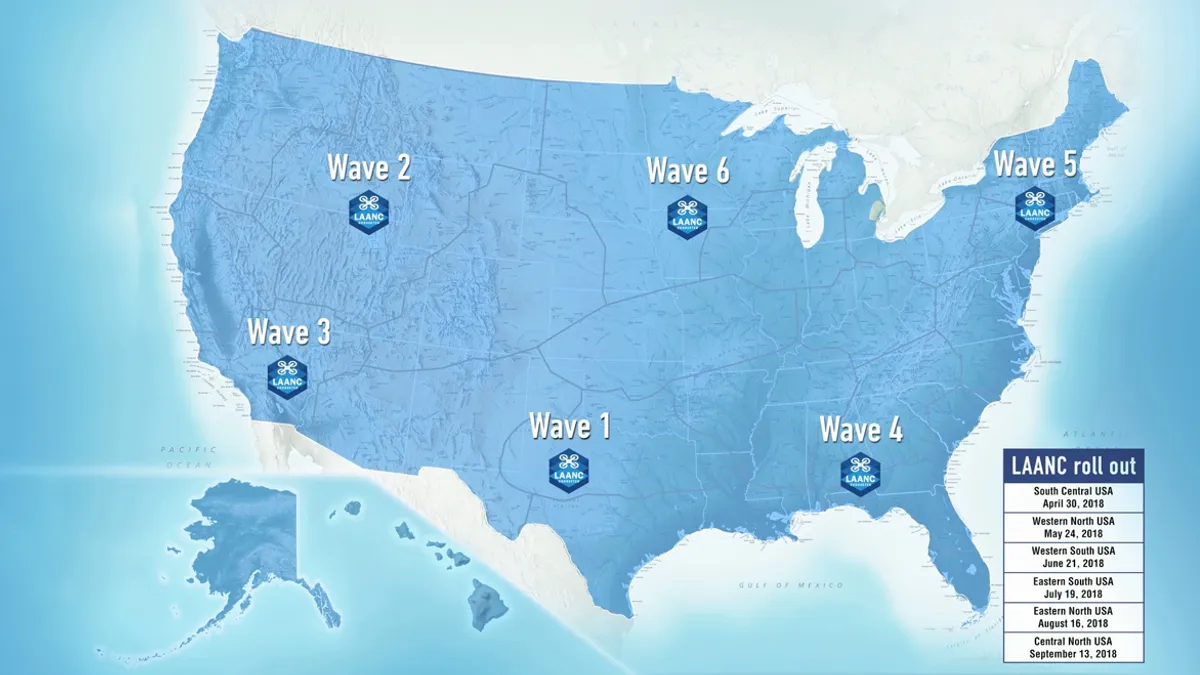Dive Brief:
- Fourteen drone industry companies can now request and receive airspace authorizations in near-real-time from the Federal Aviation Administration (FAA), as part of the regulator's Low Altitude Authorization and Notification Capability (LAANC) initiative.
- As part of LAANC, Part 107 drone operators can operate at nearly 300 FAA air traffic facilities. On Monday, nine companies — Aeronyde, Airbus, AiRXOS, Altitude Angel, Converge, DJI, KittyHawk, UASidekick and Unifly — joined AirMap, Harris Corp., Project Wing, Skyward and Thales Group in the initiative.
- The program seeks to set a foundation for the development of an Unmanned Aircraft Systems Traffic Management System, wherein the regulator and drone industry partners can exchange data beyond FAA-managed facilities and beyond line of sight.
#DYK that #LAANC capabilities are officially LIVE in the Pacific Northwest? Learn how you can get real-time access to #PNW airspace at: https://t.co/s65Y2jCIVA. pic.twitter.com/vvlfcNy7GO
— The FAA (@FAANews) May 25, 2018
Dive Insight:
The FAA's initiative is really a step toward opening up the airspace for drone operators and removing regulatory red tape, Sezen Jones, director of public policy at AirMap, told Supply Chain Dive.
Today, drone operators hoping to use the vehicles within an FAA-controlled airspace are required to go through a 90-day process to receive a certificate of authorization. But with LAANC active for pre-approved providers, and in pre-approved facilities, the red tape becomes virtually eliminated.
"What LAANC does is it enables the UAS operator to get the authorization essentially in real time, in about two seconds," Jones said. "It's showcasing how technology can really assist the [regulatory] process."
One of the coolest—yet fairly mundane—things in drone software I've seen in the past few months. Quick video demo of @AirMapIO's new @DroneDeploy integration to submit LAANC requests to @FAANews. Very smooth experience showcasing value of technology partnerships. ???? pic.twitter.com/W3VhrIxHxY
— Ian Smith (@SkyCapture) December 5, 2017
Jones explained the authorization process is especially a burden in cities with more heavily controlled airspace. San Diego, for example, is highly controlled due to the large number of airports and military bases.
In the past, drone operators were unable to use the vehicles in these regions unless they were willing to wait. However, as of Sept. 13, 2018, the FAA had formally launched LAANC at facilities across the U.S.
In other words, drone operators — from maintenance service providers to medical delivery companies — can now request to fly in most of the nation and receive permission to do so within seconds. The FAA, meanwhile, will seek to continue adding operators to the program next year.
"It's really opening up that airspace, which is a huge thing," Jones said.














